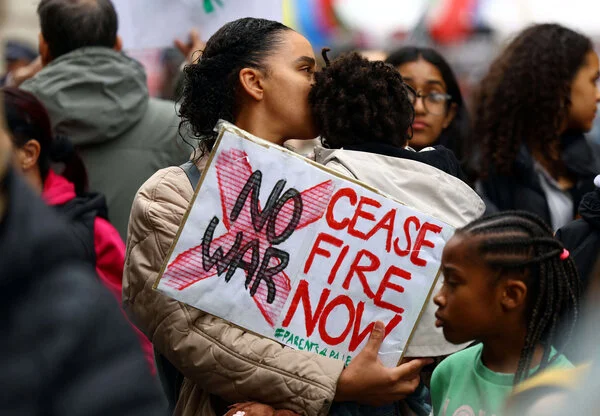Israel-Hamas truce deal: Key Highlights and Details

Following more than six weeks of intense conflict resulting in extensive destruction in Gaza and a high death toll, Israel and the Palestinian armed group Hamas have agreed to a four-day ceasefire. The conflict escalated on October 7 when Hamas fighters launched an attack in southern Israel, leading to the death of 1,200 people. In response, the Israeli army initiated a sustained campaign of air and ground attacks on Gaza, resulting in the death of over 14,000 Palestinians, predominantly women and children. Approximately 1.7 million Palestinians have been displaced, compelled by the Israeli army to seek refuge in the southern areas of the Strip. Here are the key details about the truce agreement.
What have Israel and Hamas agreed to?
- Both parties have consented to a four-day cessation of hostilities.
- As part of the agreement, Hamas has committed to releasing 50 civilian women and children from the total of 237 captives abducted since October 7.
- As a component of the arrangement, Israel has committed to releasing 150 Palestinian women and children from its prisons.
- Qatar has stated that the agreement would enable a heightened influx of humanitarian aid into Gaza.
- Israel expressed its readiness to prolong the cessation period beyond four days, indicating an extension of one day for every 10 additional hostages released by Hamas.
- The release of additional Palestinian prisoners by Israel remains uncertain in the event of an extended truce.
How did the truce happen?

Qatar played a mediating role in brokering the agreement between Israel and Hamas, leading negotiations and coordinating with global powers such as the United States and Egypt. US President Joe Biden expressed gratitude to Qatar’s Emir Sheikh Tamim bin Hamad Al Thani and Egypt’s President Abdel Fattah el-Sisi for their contributions to the breakthrough. Israeli Prime Minister Benjamin Netanyahu acknowledged leaning on Biden to secure a more favorable deal for Israel and thanked the US president for his efforts. Netanyahu emphasized that the temporary halt in fighting did not signify the end of Israel’s conflict with Gaza.
How did Israel come to approve the deal?
Following weeks of intense negotiations and several instances where potential deals seemed imminent only to unravel, Netanyahu convened a cabinet meeting on Tuesday night.
During the meeting, the Israeli prime minister laid out the proposed deal to his ministers. Only three members of his cabinet opposed the deal, including National Security Minister Itamar Ben-Gvir and two other members affiliated with his far-right political party.
What happens if either side breaks the truce?
If either side violates any terms of the agreement, there is an anticipation that hostilities may resume without restraint.
Israel, in a ground offensive late in October, deployed soldiers, tanks, armored vehicles, and other military infrastructure, and is maintaining its presence in Gaza.
What was the timeline of the deal?

On November 15, reports emerged of Qatari mediators nearing an agreement between Israel and Hamas for the release of 50 captives in Gaza in exchange for a three-day pause. Qatar’s Prime Minister Sheikh Mohammed bin Abdulrahman Al Thani acknowledged remaining “minor” and “logistical” challenges in the negotiations, characterized by “ups and downs.”
Israel’s war cabinet, as reported by Channel 12, met on Sunday, expressing readiness to advance negotiations and notify Qatar of its willingness to reach an agreement. On Monday, President Joe Biden indicated optimism about a potential deal to free captives, though the White House clarified that terms had not been finalized.
The same day, Red Cross President Mirjana Spoljaric held discussions with Hamas leader Ismail Haniyeh in Doha and engaged in separate talks with Qatari authorities. On Tuesday, Hamas official Izzat al-Rishq informed Al Jazeera that negotiations had been ongoing for weeks, accusing Netanyahu of delaying. He stated that all Palestinian resistance brigades had unanimously agreed to the deal through a phone call, and Hamas had conveyed its response to Qatari negotiators.
Wednesday morning saw the Israeli cabinet endorsing the agreement following talks on the Qatar-mediated deal. Later in the morning, both Israel and Hamas independently confirmed the temporary halt in fighting.
What’s next?
Israel’s parliament has a 24-hour window to challenge the truce agreement through its High Court. The initial exchange of captives and prisoners is anticipated to occur after this period, likely on Thursday or Friday.
James Dorsey, a senior fellow at the National University of Singapore’s Middle East Institute, shared with Al Jazeera that the temporary truce between Israel and Hamas represents just the initial phase of challenging negotiations. Achieving lasting peace in Gaza remains a distant prospect.
“What this [deal] tells you is how difficult things are going to be going forward. Once you get to the question of releasing Israeli military personnel held captive by Hamas these negotiations are going to become much more difficult.
“My sense is that Israeli Prime Minister Netanyahu was caught in a bind. On the one hand domestic pressure – which wants the hostages released and wants them released now – and, on the other hand, US pressure to allow for a truce.”

- Art
- Causes
- Best Offers
- Crafts
- Dance
- Drinks
- Film
- Fitness
- Food
- Παιχνίδια
- Festival
- Gardening
- Health
- Κεντρική Σελίδα
- Literature
- Music
- Networking
- άλλο
- Party
- Religion
- Shopping
- Sports
- Theater
- Wellness



